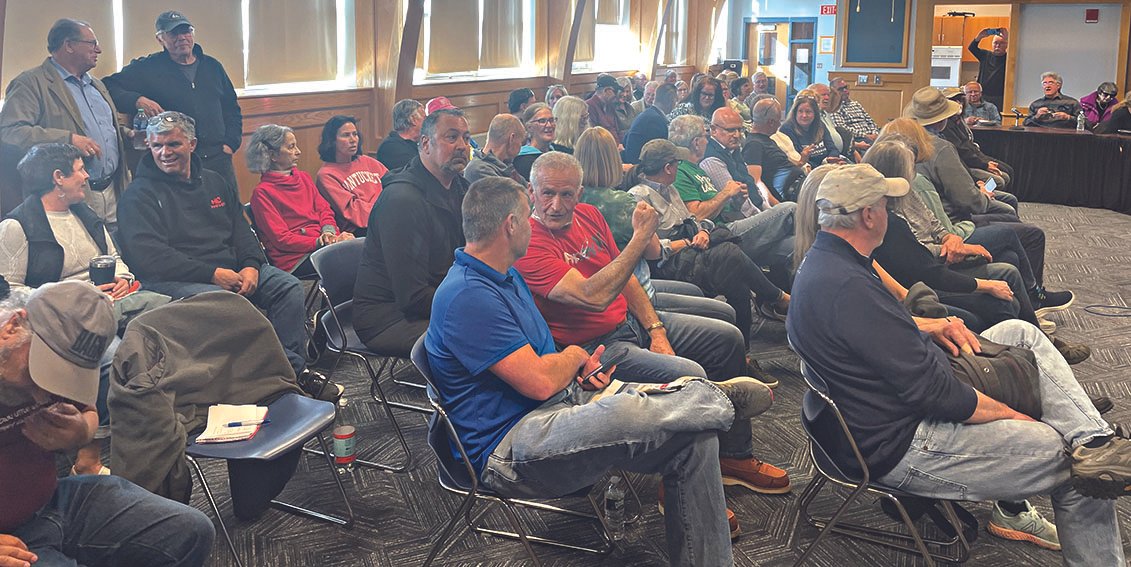Residents raise concerns about traffic, safety with seawall replacement plan
/By Carol Britton Meyer
It was standing room only during the second informational meeting about the seawall project on Nantasket Avenue near the Fitzpatrick Way lagoon, in preparation for Monday’s annual town meeting, when voters will be asked to approve about $6 million toward the town’s share of the total $15.6-million cost. (See related story.)
The purpose of the project is to reduce the risk of flood damage and coastal erosion, increase resilience against projected future sea level rise, and maintain critical links to the infrastructure, homes, and businesses on Pemberton Point.
HITTING THE WALL. On Monday, a packed room of concerned Hull residents listened as town officials and engineers give a detailed presentation on proposal to replace the seawall along Nantasket Avenue near the Fitzpatrick Way lagoon. Among those speaking during the session were Allerton Hill resident Paul Falletti, who discussed the potential changes to traffic patterns on Allerton Hill. [Photos courtesy of the Point Allerton Association]
Residents at the meeting raised concerns about changing traffic to one-way along that section of Nantasket Avenue, safety for pedestrians along the new wall, and the impact of traffic on the rest of Allerton Hill.
The existing deteriorating seawall – which was named the top priority in a recent study of Hull seawalls and other vulnerable structures in need of repair – overtops during some storms and is in bad shape due to its age and erosion.
If the seawall were to fail, everything north of the structure would be cut off from the rest of the town and vice versa, including two schools, the wastewater treatment plant, the U.S. Coast Guard station, the commuter ferry, and hundreds of homes.
Consultants provided an overview of the project and fielded numerous questions from among the dozens of residents who packed the Hull High School Exhibition Room Monday night.
The work involves replacing a large portion, about 1,675 feet, of the seawall along a section of Nantasket Avenue adjacent to 948 Nantasket Ave., Point Allerton Avenue, and Stony Beach as well as relocating overhead utilities, intersection improvements, raising a portion of the road, and creating an overlook with a view of the ocean.
The plan calls for the new seawall to be constructed landward of the existing seawall, with armor stone between the walls.
In response to a question from the audience, Russell Titmuss of GEI Consultants confirmed that the work involving cutting off part of the old seawall after the new seawall is installed.
One-way road a concern
Among residents’ concerns are the planned one-way road (direction not yet determined), additional expected traffic on Allerton Hill, the “incredible impacts” the project will have on residents, and other issues.
“There will not be enough space for the road to be two-way,” Titmuss said.
One resident suggested that the single-lane road could be one way in either direction at different times of the day, which was not ruled out as a possibility.
After a number of other residents questioned the use of stone dust for a walkway along the seawall, a request was made to have the pathway paved instead. Project engineer Kevin Mooney said that change is possible, pending conservation commission approval.
A 30-year Allerton Hill resident aired concerns shared with others living in his neighborhood about how to make the project “less burdensome” for those living in the area and suggested the money that would be used to create the overlook instead be put toward constructing a concrete sidewalk, which he considers safer and better than stone dust.
State and federal grants will cover most of the project’s cost – including associated road work – as long as the work meets certain deadlines, Mooney said. Town meeting voters will have the final say on the warrant article related to the town’s share of the costs.
Project could start this summer
The construction, with a targeted start date of mid-2024, will take about 18 to 24 months to complete, with an expected “lifespan” of at least 50 years.
“Although we can’t predict Mother Nature,” the new seawall is designed to stand up to major severe storms, according to Mooney.
Construction will take place during daylight hours, starting no earlier than 7 a.m. Rodent control is part of the contract.
The earlier town-approved matching $1 million for the $3 million state seawall grant and another $4.94 million from the Federal Emergency Management Agency will help pay for the project, with approval pending on another $665,000 federal grant. The town is expected to pay the remaining tab, hence the request for $6 million on the May 6 town meeting warrant.
In response to a question about how the new seawall will be maintained “so it doesn’t unravel,” Mooney said he’s working with the town to develop a maintenance plan for all of Hull’s coastal structures that will involve annual inspections and keeping records of storm damage, cleanups, and other work performed.
Constable noted that many meetings can be viewed on hulltv.net on demand once they are recorded, including this week’s informational session.
For full town meeting coverage, click here.
Like what you’re reading? Stay informed with a Hull Times subscription by clicking here.
Do you have an opinion on this issue? Click here to write a Letter to the Editor.













